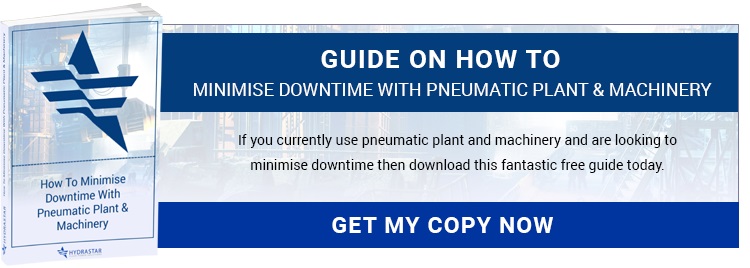“An ounce of prevention is worth a pound of cure,” wrote one Benjamin Franklin almost 300 years ago. He was talking about fire safety at the time but it’s a truism that applies to all pneumatic equipment and tools. We could itemise 99 maintenance tips. In fact, we could write a book based on our 40 years’ experience with pneumatic equipment design, construction and parts supply. However, let’s start with these:
1) Capacity Monitoring
Ensuring supply is adequate at all times can also imply controlling demand, such as monitoring the occasional use of high volume equipment like blow guns on a production line. The all too frequent workaround for inadequate supply is over-pressuring the system, when it’s only common sense to operate compressors at the lowest possible pressure level within their service parameters to minimise wear and tear. Not only does excessive operating pressure exact a cost in terms of reduced energy efficiency but it also increases the risk of leaks, or other faults that can lead to breakdown and interrupted production. Consider adding capacity to receiver tanks, thereby providing greater control over inlet modulation. Close off compressors when not in use and avoid pressure fluctuations with a sequencer or some automated control system that coordinates compressors.
2) Maintenance – Enhance Leak Management
Leakage can represent up to 20% of the energy costs of a system. Even if you outsource maintenance to a service provider, you can still implement a basic maintenance routine in-house and troubleshoot common issues with basic diagnostic tools and visual inspection. Build in a sound and workable leak awareness and reduction strategy. Allied with proper training, that will raise the level of leak detection and remediation, thus improving efficiency. The pipe run is the most common source of leaks. Frequently, damage caused by operating equipment colliding with pipework causes a leak. Also, pipework must be rigidly supported along its entire run and tightly anchored to the support structure to absorb operating loads. Check for loose or damaged retaining brackets frequently.
3) Maintenance – Renew Focus On Filters
Consistent air quality depends on filter cartridges being regularly replaced and that warrants close attention being paid to filters, thereby avoiding or minimising the incidence of clogged or ruptured filters. While the differential pressure gauge may indicate when a filter needs to be replaced, a high differential may only become apparent during peak usage. In that scenario, indications that filters need to be replaced can very easily be missed. Or the differential may be totally eliminated by a ruptured filter that allows unfiltered air to contaminate the system. Also check the intake filter and clean it or replace it if needs be. Dirt reduces the mass air inflow meaning the intake vacuum is greater than the original design specification and this can have a major impact and degradation on performance.
4) Repairs – Use Top Quality Parts Suppliers
Identify the best parts suppliers and weed out those that present issues like these:
- Frequent price changes and sudden price hikes – these are often symptoms of other hidden problems
- Poor range of parts – you want a one stop shop ideally
- Parts frequently out of stock – wastes your time having to try several suppliers
- Patchy delivery times – downtime is expensive, delays add to that
- Lack of engineering expertise – use suppliers who will assist your engineers in solving production line issues
- Low technical knowledge – you want dependable answers and the right part first time
Download Our FREE Ebook
Find out more about reducing downtime and saving on maintenance costs in our new free guide: How To Minimise Downtime On Pneumatic Systems. Access your copy today by clicking here.


